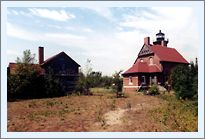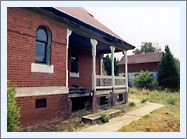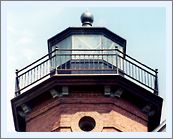|
Historical
Information

Squaw Island, is the northernmost island in the Beaver Island
archipelago, sitting approximately three miles West-Northwest of Garden
Island. Marking the western edge of the busy Grays Reef Passage, the
island is surrounded by shoals with as little water depth as six feet
extending almost a mile to the south and two miles to the north.
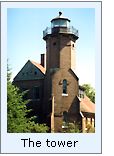 To warn mariners making the passage,
Congress appropriated the sum of $25,000 to establish a light station on
the island on March 3, 1891. The Lighthouse Board began negotiations for
the purchase of land on the island immediately, and on June 23rd issued
contracts for the construction of the fog signal equipment specified in
the station plans. To warn mariners making the passage,
Congress appropriated the sum of $25,000 to establish a light station on
the island on March 3, 1891. The Lighthouse Board began negotiations for
the purchase of land on the island immediately, and on June 23rd issued
contracts for the construction of the fog signal equipment specified in
the station plans.
While the necessary equipment arrived
at the Detroit Depot on September 1st, construction on the island did
not start until the following spring, when the lighthouse engineer's
tender Amaranth anchored offshore, and off-loaded a work crew who
shuttled the tons of material to the shore. With the materials unloaded,
the Amaranth steamed off to work on other projects.
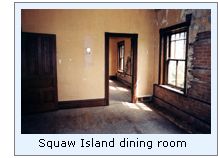 The station's plans called for the
construction of a brick main building with an integrated octagonal
tower, capped with a prefabricated cast iron lantern. As work progressed
through the summer, the station complex took shape with the addition of
a fog signal building, oil storage house, two-seater outhouse,
wood-framed barn and well head building. The fog signal building was
equipped with a duplicate set of steam-powered 10-inch steam whistles to
be used during thick weather. The installation of duplicate systems
ensured that one of the two units would always be available to scream
its warning across the lake to mariners making their way through the
passage. The station's plans called for the
construction of a brick main building with an integrated octagonal
tower, capped with a prefabricated cast iron lantern. As work progressed
through the summer, the station complex took shape with the addition of
a fog signal building, oil storage house, two-seater outhouse,
wood-framed barn and well head building. The fog signal building was
equipped with a duplicate set of steam-powered 10-inch steam whistles to
be used during thick weather. The installation of duplicate systems
ensured that one of the two units would always be available to scream
its warning across the lake to mariners making their way through the
passage.
 Finally, cribs were constructed on the
east side of the island to support a landing dock for the use of the
keepers and the delivery of supplies. A wood-railed track was laid
connecting the dock with the main building and the fog signal, and a
small rail car was installed on the track for use in the movement of
oil, coal and other supplies from the dock to the appropriate buildings
in which they were used. Finally, cribs were constructed on the
east side of the island to support a landing dock for the use of the
keepers and the delivery of supplies. A wood-railed track was laid
connecting the dock with the main building and the fog signal, and a
small rail car was installed on the track for use in the movement of
oil, coal and other supplies from the dock to the appropriate buildings
in which they were used.
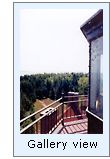 Amaranth returned to the island
later that summer to deliver the district lampist, whose task it was to
install and adjust the new Fourth Order Fresnel
lens, which had been
custom-manufactured for the station in Paris. The red lens rotated
around the lamp, and equipped with bullseye panels was designed to make
the light appear to flash a bright red every fifteen seconds. Thus,
adjustment of the lens's clockwork rotational mechanism was critical to
ensure a precise speed of rotation. Amaranth returned to the island
later that summer to deliver the district lampist, whose task it was to
install and adjust the new Fourth Order Fresnel
lens, which had been
custom-manufactured for the station in Paris. The red lens rotated
around the lamp, and equipped with bullseye panels was designed to make
the light appear to flash a bright red every fifteen seconds. Thus,
adjustment of the lens's clockwork rotational mechanism was critical to
ensure a precise speed of rotation.
Work on the island was completed on
September 16th, when the Amaranth returned to return the work crew and
left over supplies to the lighthouse depot. William H. Shields was
appointed as the station's head keeper, and on the evening of October
10th, 1892, Shields climbed the cast iron stairs within the tower and
exhibited the light for the first time.
 Over the next two years, it became
plain that the dwelling was too small for both the head keeper and
assistant keeper and their families. In 1894 the answer came in the form
of the tender Amaranth, which again delivered a work crew and materials
to the island to convert the original barn into a separate dwelling. On
completion, Shields moved into the converted barn, and his assistant
lived on the second floor of the main building, with the first floor
being used as a common area for cooking and washing purposes. Over the next two years, it became
plain that the dwelling was too small for both the head keeper and
assistant keeper and their families. In 1894 the answer came in the form
of the tender Amaranth, which again delivered a work crew and materials
to the island to convert the original barn into a separate dwelling. On
completion, Shields moved into the converted barn, and his assistant
lived on the second floor of the main building, with the first floor
being used as a common area for cooking and washing purposes.
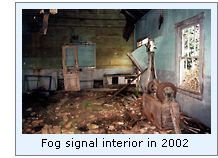 On December 14, at the close of the
1900 navigation season, Shields, his wife, assistant keeper Owen C.
McCauley, 2nd assistant Lucien F. Morden and Shield's niece Lucy Davis
loaded their belongings in the station's 25-foot sailboat and set sail
to winter on Beaver Island. An unexpected storm rolled-in, and capsized
their sailboat, tossing all five into the icy water. Morden and both
women quickly perished, however Shields and McCauley somehow managed to
survive the night, to be rescued the following day by the steamer
MANHATTAN. As a result of the disaster, Shields lost a leg, and after
recovery was transferred to "lighter" duty at the lighthouse
depot in Charlevoix. On December 14, at the close of the
1900 navigation season, Shields, his wife, assistant keeper Owen C.
McCauley, 2nd assistant Lucien F. Morden and Shield's niece Lucy Davis
loaded their belongings in the station's 25-foot sailboat and set sail
to winter on Beaver Island. An unexpected storm rolled-in, and capsized
their sailboat, tossing all five into the icy water. Morden and both
women quickly perished, however Shields and McCauley somehow managed to
survive the night, to be rescued the following day by the steamer
MANHATTAN. As a result of the disaster, Shields lost a leg, and after
recovery was transferred to "lighter" duty at the lighthouse
depot in Charlevoix.
McCauley faired somewhat better, and
was promoted to the position of head keeper at Squaw Island at the
opening of the 1901 navigation season.
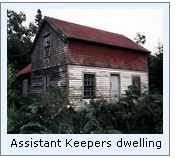 With construction of the Lansing Shoal
light station offshore in 1928, the Squaw Island light was deemed
obsolete, and the station was abandoned. With the closing of Squaw
Island, McCauley was transferred to St. Joseph Light, where he served as
head keeper until his retirement in April 1935. McCauley passed away in
St. Joseph in 1958. With construction of the Lansing Shoal
light station offshore in 1928, the Squaw Island light was deemed
obsolete, and the station was abandoned. With the closing of Squaw
Island, McCauley was transferred to St. Joseph Light, where he served as
head keeper until his retirement in April 1935. McCauley passed away in
St. Joseph in 1958.
Abandoned, the buildings quickly began
to deteriorate. Vandals arrived on the island to unleash their
destructive stupidity and with the windows and doors broken out birds
and bats roosted and nested throughout the building. Squaw Island passed into private
ownership, and on behalf of the current owners, Bernie Hellstrom has
spent a great deal of the past ten years stabilizing and restoring
the station's buildings to prevent their loss to posterity.

Keepers of
this light

Click Here
to see a complete listing of
all Squaw Island Light keepers compiled by Phyllis L. Tag of Great Lakes
Lighthouse Research.

Finding this Light

Squaw Island is privately owned in its entirety, and landing on the
island would therefore be considered trespassing. Thus visitors are
strongly encouraged to respect the rights of the owners, and are discouraged
from attempting to visit the island.

Reference Sources

Email from Thomas A. Tag on McCauley & the station's lens.
Lighthouse Board Annual Reports, 1891, 1893, 1894 & 1900
Various emails on station history from Bernie Hellstrom.
Coast Pilot 6, 2000, NOAA
Northern Lights,
Charles K. Hyde, 1995
Keeper listings for this light appear courtesy of Great
Lakes Lighthouse Research
|
